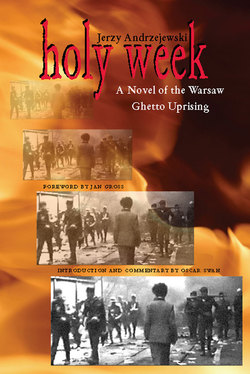Читать книгу Holy Week - Jerzy Andrzejewski - Страница 12
На сайте Литреса книга снята с продажи.
ОглавлениеNote on the Warsaw Ghetto Uprising
THE WARSAW GHETTO UPRISING was the largest and symbolically most important Jewish uprising during World War II and the first urban uprising in German-occupied Europe.
In the summer of 1942, around three hundred thousand Jews were deported from the Warsaw Ghetto to Treblinka. When reports of the mass murder of the deportees leaked back, a group of survivors formed the Jewish Fighting Organization (Żydowska Organizacja Bojowa) under the command of Mordecai Anielewicz. Right-wing Zionists formed another resistance organization, the Jewish Fighting Union (Żydowski Związek Wojskowy). The two groups decided to cooperate to oppose German attempts to destroy the ghetto.
In January 1943, using a small supply of smuggled weapons, members of the Jewish resistance infiltrated a column of deportees and began firing upon the German troops. Although the Germans succeeded in deporting some five thousand to sixty-five hundred people, after a few days the troops retreated. This momentary victory inspired the ghetto fighters to prepare for future resistance, among other things by building a network of underground bunkers.
On April 19, 1943, German troops and police entered the ghetto to deport its remaining inhabitants, and the Warsaw Ghetto uprising began. Some 750 fighters, using mostly small arms and grenades smuggled into the ghetto by the Polish resistance, fought the heavily armed and well-trained German army.
On the third day of the uprising, in order to force the remaining Jews out of hiding, troops under the command of SS General Jürgen Stroop began to systematically burn the ghetto, building by building. Anielewicz and those with him were killed in an attack on his command bunker, which fell to German forces on May 8. By May 16, 1943, after nearly a month of resistance, the ghetto was in ruins and the revolt had ended. General Stroop ordered the Great Synagogue on Tłomacki Street destroyed as a symbol of German victory. Stroop reported that he had captured 56,065 Jews and destroyed 631 bunkers. He estimated that his units had killed as many as seven thousand Jews. Another seven thousand were deported to Treblinka to be killed. The remainder of the ghetto inhabitants were deported to the Poniatowa, Trawniki, and Majdanek concentration camps.
The last commander of the Jewish uprising, Marek Edelman, survived the war and became a prominent physician in Łódź. As of this writing, he is still alive and politically active.
